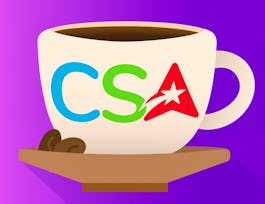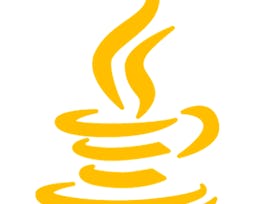Learn to code in Java and improve your programming and problem-solving skills. You will learn to design algorithms as well as develop and debug programs. Using custom open-source classes, you will write programs that access and transform images, websites, and other types of data. At the end of the course you will build a program that determines the popularity of different baby names in the US over time by analyzing comma separated value (CSV) files.





Java Programming: Solving Problems with Software
This course is part of multiple programs.



Instructors: Owen Astrachan
Sponsored by Barbados NTI
391,165 already enrolled
(7,974 reviews)
Skills you'll gain
Details to know

Add to your LinkedIn profile
16 assignments
See how employees at top companies are mastering in-demand skills

Build your subject-matter expertise
- Learn new concepts from industry experts
- Gain a foundational understanding of a subject or tool
- Develop job-relevant skills with hands-on projects
- Earn a shareable career certificate


Earn a career certificate
Add this credential to your LinkedIn profile, resume, or CV
Share it on social media and in your performance review

There are 5 modules in this course
Welcome to “Java Programming: Solving Problems with Software”! We are excited that you are starting our course to learn how to write programs in Java, one of the most popular programming languages in the world. In this introductory module, you will get to meet the instructor team from Duke University and have an overview of the course. Have fun!
What's included
5 videos1 reading
In this module, you will learn to write and run your first Java programs, including one program that prints “Hello!” in various countries’ languages and another where you will analyze the perimeters and other information of shapes. To accomplish these tasks, you will learn the basics of Java syntax and how to design stepwise solutions with programs. By the end of this module, you will be able to: (1) Download and run BlueJ, the Java programming environment for this course; (2) Access the documentation for the Java libraries specially designed for this course; (3) Edit, compile, and run a Java program; (4) Construct methods, variables, if else statements, and for each loops in Java; and (5) Use Iterables (like DirectoryResource) to run a program that iterates over multiples lines in a document or webpage or multiple files in a directory.
What's included
17 videos10 readings5 assignments1 plugin
This module begins with a short presentation from Raluca Gordân, an assistant professor in Duke University’s Center for Genomic and Computational Biology, about an important problem genomics scientists encounter regularly: how to identify genes in a strand of DNA. To tackle this problem, you will need to understand strings: series of characters such as letters, digits, punctuation, etc. After learning about Java methods that work with strings, you will be able to find genes within a DNA string as well as tackle other string related problems, such as finding all of the links in a web page. By the end of this module, you will be able to: (1) Use important methods for the Java String class; (2) Use conditionals, for loops, and while loops appropriately in a Java program; (3) Find patterns in the data represented by strings to help develop the algorithm for your program; (4) Understand the importance of designing programs that keep different data processing steps separate; (5) Use the StorageResource iterable for this course to store some data for further processing; and (6) Rely on Java documentation to better understand how to use different Java packages and classes.
What's included
21 videos3 readings6 assignments1 discussion prompt
A common format for storing tabular data (any data organized into columns and rows) is in comma separated values (CSV) files. In this module, you will learn how to analyze and manipulate data from multiple CSV data files using a powerful open-source software package: Apache Commons CSV. Using this library will empower you to solve problems that could prove too complex to solve with a spreadsheet. By the end of this module, you will be able to: (1) Use the open-source Apache Commons CSV package in your own Java programs; (2) Access data from one or many CSV files using Java; (3) Convert strings into numbers; (4) Understand how to use “null” in Java programs (when you want to represent “nothing”); (5) Devise an algorithm (and implement in Java) to answer questions about CSV data; and (6) Analyze CSV data across multiple CSV files (for example, find maximums, minimums, averages, and other simple statistical results).
What's included
14 videos3 readings3 assignments
This module wraps up the course with a mini project that ties together the different practices, skills, and libraries you have gained across the course! Using data on the popularity of different baby names in the United States from the past several decades, you will be able to compare different names’ popularity over time. While the data we have collected for this course is from the United States, we welcome you to share data from other countries in the course discussion forums. Good luck with the mini project!
What's included
9 videos3 readings2 assignments
Instructors


Offered by
Why people choose Coursera for their career




Learner reviews
7,974 reviews
- 5 stars
72.36%
- 4 stars
19.28%
- 3 stars
4.04%
- 2 stars
1.30%
- 1 star
2.99%
Showing 3 of 7974
Reviewed on Jul 11, 2022
This course helps to develop strong problem solving skills which is an essential tool in the your journey to becoming a Java programmer. i would recomment this course to any newbie learning JAVA
Reviewed on May 18, 2019
Really practical course content with great tutorials. The programming assignments are fun and challenging and deal with real world data and problems which makes the course all the more useful!
Reviewed on Feb 25, 2019
A basic practice approach for solving problems with a 7step formula for any kind of problem set, for any kind of programming language you use. A very basic approach to JAVA syntax and semantics.
Recommended if you're interested in Computer Science

University of California San Diego

University of London

LearnQuest

Open new doors with Coursera Plus
Unlimited access to 10,000+ world-class courses, hands-on projects, and job-ready certificate programs - all included in your subscription
Advance your career with an online degree
Earn a degree from world-class universities - 100% online
Join over 3,400 global companies that choose Coursera for Business
Upskill your employees to excel in the digital economy




